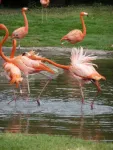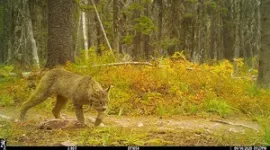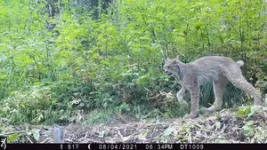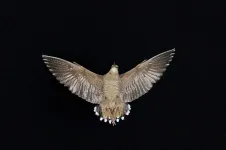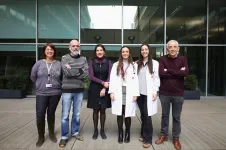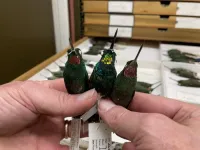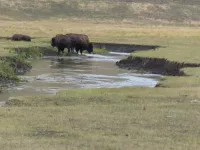(Press-News.org) Flamingos form cliques of like-minded individuals within their flocks, new research shows.
Scientists analysed the personalities and social behaviour of Caribbean and Chilean flamingos.
Birds of both species tended to spend time with others whose personality was similar to their own.
The study, by the University of Exeter and the Wildfowl & Wetlands Trust (WWT), reveals the complex nature of flamingo societies and could help in the management of captive flocks.
“Our previous research has shown that individual flamingos have particular ‘friends’ within the flock,” said Dr Paul Rose, from WWT and Exeter’s Centre for Research in Animal Behaviour.
“In this study, we wanted to find out whether individual character traits explain why these friendships form.
“The answer is yes – birds of a feather flock together.
“For example, bolder birds had stronger, more consistent ties with other bold birds, while submissive birds tended to spend their time with fellow submissive flamingos.”
The “personality” of flamingos was assessed by measuring consistent individual differences, such as aggressiveness and willingness to explore.
“Like humans, flamingos appear to carve out different roles in society based on their personality,” said Fionnuala McCully, now at the University of Liverpool, who collected data for the study during an MSc Animal Behaviour course at the University of Exeter.
“For example, we observed groups of aggressive birds which attempt to dominate rivals and tend to get in more fights.
“Meanwhile, the role of submissive birds may be more complex than simply being lower down the pecking order – they may be using a different approach to get what they need.
“The various different personality groups provide social help to their members, for example by supporting each other in the many squabbles that take place in flamingo flocks.”
In the Caribbean flamingos, birds of a certain personality type had a particular role within the group overall, but this was not found in the Chilean flock. The reasons for this are unclear, and it’s possible that a larger study of wild birds would find such a pattern.
Dr Rose said: “Our findings need further investigation, both to help us understand the evolution of social behaviour and to improve the welfare of zoo animals.
“But it is clear from this research that a flamingo's social life is much more complicated than we first realised.”
The findings are based on observations of captive flamingos at WWT Slimbridge.
The paper, published in the journal Scientific Reports, is entitled: “Individual personality predicts social network assemblages in a colonial bird.”
END
Flamingos form cliques with like-minded pals
2023-03-01
ELSE PRESS RELEASES FROM THIS DATE:
Social workers experienced depression, PTSD, and anxiety at alarming rates during pandemic
2023-03-01
Toronto, ON — A new study published in the journal International Social Work has uncovered concerning rates of depression, post-traumatic stress disorder (PTSD) and anxiety among social workers.
Stressors related to COVID-19 were the strongest factors associated with the negative mental health outcomes. Those who experienced a higher number of pandemic-related stressors — such as health concerns, increased caregiving responsibilities, violence in the home, family stress due to confinement, and stress associated with work-life balance — experienced mental health problems ...
Woodcocks have the brightest white feathers ever measured
2023-03-01
The mainly brown woodcock uses its bright white tail feathers to communicate in semi-darkness, reflecting 30% more light than any other known bird.
These surprise findings, by a team led by an Imperial College London scientist, suggest there is much to learn about how birds that are most active at night or at dawn and dusk communicate.
Birds that are most active during the day often have colourful plumages, which they use to communicate information with each other. Birds that are most active at dawn and dusk or at night (‘crepuscular’), such as nightjars and woodcocks, tend to have less showy plumage, as while sleeping during ...
Marker discovered which shows when a type of skin cancer is preparing to metastasise
2023-03-01
Cells that form cutaneous squamous cell carcinoma tumours prepare themselves to migrate to the lymph nodes to metastasise other organs, and they make changes so that they can survive this process. According to a study led by researchers from the Inflammatory and Neoplastic Dermatological Diseases Research Group at the Hospital del Mar Medical Research Institute, published in the journal Life Science Alliance, these cells stop consuming glucose so that they can survive by using LDL cholesterol molecules, the ...
Conversations about safe firearm storage at purchase can influence use of firearm locks
2023-03-01
Although cable locks – commonly distributed to prevent firearm injury and death – are included in many legal firearm purchases, research shows firearm owners rarely prefer or use these devices.
But a Rutgers study published in Injury Epidemiology found that gun owners who were told about cable locks at the time they purchased the firearm were more than twice as likely to use locking devices than those who weren’t told about cable locks when they made these purchases.
“Simply placing a cable lock in a bag when somebody purchases a firearm likely has minimal impact, but a simple discussion mentioning that a lock was included may make enough of an ...
Daily 11 minute brisk walk enough to reduce risk of early death, say Cambridge researchers
2023-03-01
One in ten early deaths could be prevented if everyone managed at least half the recommended level of physical activity, say a team led by researchers at the University of Cambridge.
In a study published today in the British Journal of Sports Medicine, the researchers say that 11 minutes a day (75 minutes a week) of moderate-intensity physical activity – such as a brisk walk – would be sufficient to lower the risk of diseases such as heart disease, stroke and a number of cancers.
Cardiovascular diseases – such as heart disease and stroke – are the leading cause of death globally, ...
Pink + pink = gold: hybrid hummingbird’s feathers don’t match its parents
2023-03-01
The Pink-throated Brilliant hummingbird, Heliodoxa gularis, has, unsurprisingly, a brilliant pink throat. So does its cousin, the Rufous-webbed Brilliant hummingbird, Heliodoxa branickii. When scientists found a Heliodoxa hummingbird with a glittering gold throat, they thought they might have found a new species. DNA revealed a different story: the gold-throated bird was a never-before-documented hybrid of the two pink-throated species.
John Bates, the senior author of a new study in the journal Royal Society Open Science reporting on the hybrid, first encountered the unusual bird while doing fieldwork in Peru’s Cordillera ...
Researchers identify three intestinal bacteria found in dementia with Lewy bodies
2023-03-01
Dementia with Lewy bodies (DLB), one of the most common forms of dementia, has no cure. Previous studies suggested that gut bacteria, the microorganisms that live in the human digestive tract, play a role in Parkinson’s disease, another neurodegenerative disorder, but the bacteria involved in DLB had not been identified. Now, a group led by researchers at the Nagoya University Graduate School of Medicine in Japan has identified three bacteria involved in DLB: Collinsella, Ruminococcus, and Bifidobacterium. Their findings, reported in npj Parkinson's ...
Scientists find that bison are impacting streams in Yellowstone National Park
2023-03-01
Greater numbers of Bison in Yellowstone National Park may come at a cost to the biological diversity of the important streamside habitats of the Park according to a new report in the journal Ecosphere Bison influences on composition and diversity of riparian plant communities in Yellowstone National Park. Riparian areas (streamside zones) form the interface between terrestrial and aquatic ecosystems and are hotspots of biodiversity and productivity in the public lands of the Western USA. The study findings are that ...
Keto vs vegan: Study of popular diets finds over fourfold difference in carbon footprints
2023-03-01
For those on keto or paleo diets, this may be tough to swallow.
A new study from Tulane University which compared popular diets on both nutritional quality and environmental impact found that the keto and paleo diets, as eaten by American adults, scored among the lowest on overall nutrition quality and were among the highest on carbon emissions.
The keto diet, which prioritizes high amounts of fat and low amounts of carbs, was estimated to generate almost 3 kg of carbon dioxide for every ...
Centuries of whaling data highlight likely climate change effect
2023-03-01
Southern right whales adjusted their foraging grounds over the past 30 years as climate change altered where prey could be found, according to a University of Auckland, Waipapa Taumata Rau scientist.
Dr Emma Carroll, of the School of Biological Sciences, was senior author of a paper which used data gleaned from contemporary whale skin samples along with whaling records stretching back to 1792. Over the past three decades, the whales increased their use of mid-latitude foraging grounds in the south Atlantic and southwest Indian oceans in the late summer and autumn, according to Carroll and dozens of collaborators including lead author Solène Derville, of Oregon State University.
The ...
